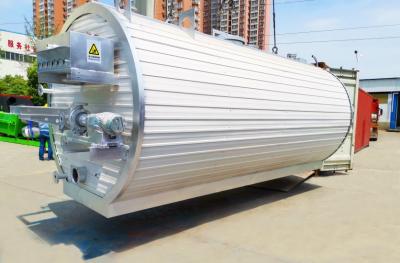The Aggregate of the Concrete Mixing Plant
Concrete aggregates are granular loose materials that act as a skeleton or filler in concrete. It is divided into coarse and fine aggregates. Coarse aggregate refers to pebbles, gravel, etc., while fine aggregate refers to natural sand, artificial sand, etc.
Aggregates with a particle size greater than 4.75 mm are called coarse aggregates, commonly known as stones. The two commonly used types are crushed stone and pebbles. Crushed stone is natural rock or rock made by mechanical crushing and sieving, with a particle size greater than 4.75 mm. Pebbles are rock particles with a particle size greater than 4.75 mm, made by natural weathering, water transport and sorting and accumulation. Pebbles and gravel particles with a length greater than 2.4 times the average particle size of the corresponding particle class to which they belong are needle particles; those with a thickness less than 0.4 times the average particle size are flake particles (the average particle size is the average of the upper and lower particle sizes of the class). Pebbles and gravel for construction should meet the technical requirements of the national standard GB/T 14685-2001 "Pebbles and gravel for construction".
Aggregates with a grain size of 4.75 mm or less are called fine aggregates, commonly known as sand. Sand is divided into two categories according to the source of production: natural sand and artificial sand. Natural sand is formed by natural weathering, water transport and sorting, and accumulation of rock particles with a grain size of less than 4.75 mm, but does not include particles of soft and weathered rocks. Natural sands include river sands, lake sands, mountain sands and desalinated sea sands. Artificial sand is the collective name of the mechanism sand and mixed sand after soil removal treatment.
The quality requirements for fine aggregates (artificial sand and natural sand) in the Code of Construction of Hydraulic Concrete (DL/T5144-2015) are:
1. Fine aggregate should be hard, clean, well-graded; artificial sand fineness modulus and in the range of 2.4 ~ 2.8, natural sand fineness modulus should be in the range of 2.2 ~ 3.0. The use of mountain sand, coarse sand, should take the appropriate test evidence.
2. Fine aggregate in the mining process should be regularly or according to a certain number of mining alkali activity test, there are potential hazards period, should take appropriate measures, and by special test demonstration.
3. Fine aggregate moisture content should be maintained stable, artificial sand saturated surface dry moisture content should not exceed 6%, if necessary, should be taken to accelerate dehydration measures.



